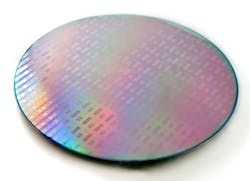Imec reveals chip-based hyperspectral imager, biosensor partnership, and spinoff funding
Leuven, Belgium--Imec has been very busy of late. The Belgian nanophotonics and nanotechnology research center has developed a low-cost and compact hyperspectral imager, is partnering with Genalyte to develop and commercialize a silicon-photonics-based disposable biosensor, and reports that its molecular detection and imaging spinoff company Pepric concluded a substantial capital round of funding.
Compact CMOS hyperspectral imager
Imec developed a hyperspectral camera solution based on a system-on-chip image sensor with an integrated hyperspectral sensor that targets multiple industrial vision applications. Combining spectroscopy and imaging, the chip-based solution is useful in time-critical or high-throughput applications.
The CMOS-compatible hyperspectral sensor consists of a set of spectral filters that are directly post-processed at wafer level on top of a commercially available CMOSIS CMV4000 image sensor (a 4 megapixel sensor with a maximum frame rate of 180 fps). The hyperspectral filter, developed at Imec, has100 spectral bands between 560 and 1000 nm and the transmission efficiency of the filters is around 85%. Typical integration times used in the current prototype setup are between 2 and 10 ms under halogen light of 450 W, which enables frame rates up to 500 fps.
The speed of the system corresponds to an equivalent speed of 2000 lines per second, significantly exceeding current state-of-the-art hyperspectral sensors. The hyperspectral filter can be tuned by changing the number of spectral bands and their spectral resolution.
Partnership with Genalyte on disposable biosensors
Imec and Genalyte (San Diego, CA) have successfully developed and produced a set of disposable silicon photonics biosensor chips to be used in Genalyte diagnostic and molecular detection equipment. The chips combine Imec’s standard silicon photonic waveguide devices with bio-compatible modifications jointly developed by Imec and Genalyte, allowing for high levels of multiplexed biosensing.
Imec developed a bio-compatible passivation technology on 200 mm wafers. The chips were tested in the field and proven to meet Genalyte's functional requirements with high yields. The chips contain up to 128 proprietary ring resonator sensors coated by Genalyte with application-specific chemistry to create very sensitive molecular detection capability. On-chip grating couplers are used to couple the infrared light from and to Genalyte's diagnostic equipment.
The ability to use standard microelectronic CMOS manufacturing facilities and processes to realize optical functions makes silicon photonics commercially very attractive because of the potential to lower manufacturing costs and increased volume production. Via its CMORE initiative, Imec offers companies all the services needed to turn innovative ideas into packaged microsystem products. Through its alliances, Imec can also offer a path to transfer the technology to a foundry for volume production.
Spinoff funding
Pepric, a spinoff of Imec located on the Imec campus that develops and commercializes equipment for quantitative molecular detection and imaging, successfully concluded a $1.8 million dollar capital round. Pepric says its tools will allow pre-clinical centers to evaluate the efficacy of new therapies and to perform early diagnosis.
The investment will support the production and commercialization of Pepric's first product: the analysis tool for quantitative molecular and cellular detection in tissue, urine, and blood samples. Furthermore it will enable Pepric to develop its core technology towards detection and imaging within the body (in-vivo).
An important part of this capital round was financed with means form SOFI, the Spin-Off Financing Instrument being created to support spinoffs from the four Flemish Strategic Research Centres (IBBT, imec, VIB en VITO). Also FIDIMEC, the spinoff investment vehicle of imec, participated in this round.
SOURCES: Imec; www2.imec.be/be_en/press/imec-news/imechyperspectralcamera.html and www2.imec.be/be_en/press/imec-news/imecgenalyte.html and www2.imec.be/be_en/press/imec-news/pepriceng2012.html

Gail Overton | Senior Editor (2004-2020)
Gail has more than 30 years of engineering, marketing, product management, and editorial experience in the photonics and optical communications industry. Before joining the staff at Laser Focus World in 2004, she held many product management and product marketing roles in the fiber-optics industry, most notably at Hughes (El Segundo, CA), GTE Labs (Waltham, MA), Corning (Corning, NY), Photon Kinetics (Beaverton, OR), and Newport Corporation (Irvine, CA). During her marketing career, Gail published articles in WDM Solutions and Sensors magazine and traveled internationally to conduct product and sales training. Gail received her BS degree in physics, with an emphasis in optics, from San Diego State University in San Diego, CA in May 1986.
